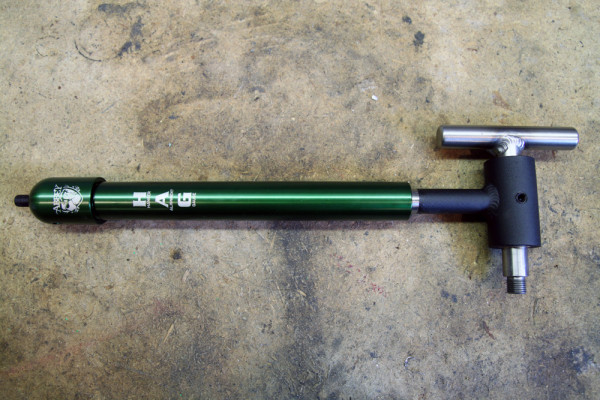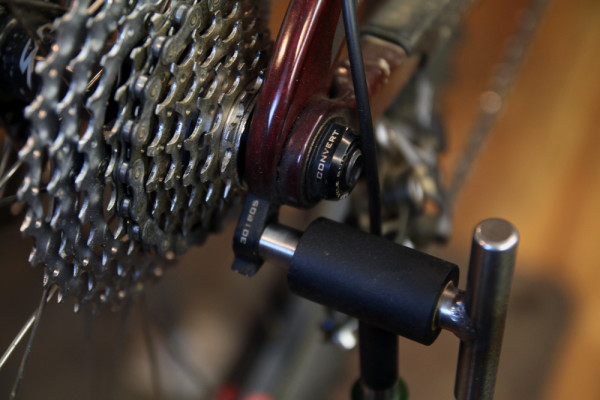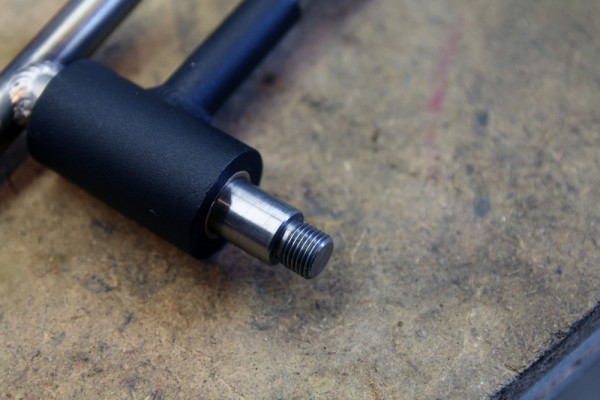The derailleur hanger is an interesting part of your bicycle that probably doesn’t get the attention it deserves. Originally one with the frame (still is on many bikes), the replaceable model was introduced so that if your derailleur was ripped off in a crash you could replace the hanger and save the bike. Many were made out of softer metal so that the hanger would break before the derailleur, which was fine until the number of gears in a cassette started creeping up, requiring more precision and a stiffer hanger.
No matter what the frame though, one thing is universal – for the best shifting, the hanger has to be precisely aligned. That presents its own set of challenges as well as a number of tools to go along with it. Actually, just a handful of tools as the relatively simple hanger alignment gauge hasn’t seen much improvement over the years. In typical Abbey Bike Tools fashion, Jason Quade thought it could be done better. When he was done the Abbey HAG or Hanger Alignment Gauge was born.
Part Pry Bar and part Precision Measuring Instrument in Jason’s own words, using the HAG will make you want to check your hanger alignment a lot more often…
First and foremost, Jason builds his tools for the traveling mechanic. That means they have to be portable, but also extremely durable so they won’t break down in the field. To make the HAG as compact as possible, the feeler gauge stores in the handle with a knurled end that holds it in place with a friction fit. When you’re ready to use the tool, pull out the feeler, slip it into the horizontal bore, then thread the nut clockwise to lock it in place when you have your measurement.
The moving and adjusting of the feeler does have a bit of a learning curve, but once you have it down it’s like second nature.
Due to the telescoping design of the tool, it packs up much more compact than something like the Park DAG-2 at just under 11 inches long, but still provides the full range of adjustment. Again perfect for the traveling mechanic, but also it will take up less room in your tool box at the shop. Even though the HAG is beautiful enough for me to want to stare at it all day, it gets kept in the drawer with the expensive tools like torque wrenches. It’s just too nice.
That telescoping design also means there is nothing holding the two halves of the tool together other than an o-ring seal, tight tolerances, and the vacuum it creates. You can easily pull them apart, but the vacuum inside the handle is strong enough to keep the bottom half from falling off if you need to grab something. It probably won’t stay there all day, but isn’t like it will fall right off.
Those tolerances for the HAG are as tight as a 1/4 of a thousandth of an inch, or 0.0063mm. And you can feel it. Every part of the tool functions with silky smooth efficiency. Should you ever wear the tool out, it is rebuildable which means it should last a life time.
I put together a quick video to highlight the HAG’s ability to swivel while keeping the feeler gauge adjustment locked in place. Yes, I know that’s not how you align a derailleur hanger, the point is to show just how easy it is to work the tool around the frame. As far as I’m concerned this is one of the best features of the HAG, and greatly contributes to the ridiculous precision afforded by the tool. No fumbling with the derailleur and chain to get the feeler around it, no accidentally bumping the gauge on the tire or rim and losing your adjustment. Just simple, smooth accuracy.
The other huge advantage of the HAG over competition? The fact that it seems to fit more bikes. Park updated the DAG with the no. 2 not all that long ago, presumably to fit bikes like the Trek ABP frames where the barrel was too big. While I sympathize with Park knowing how difficult it must be to design a tool that will work with every frame, I was still pretty bummed to find out that it didn’t fit our 9Zero7 Whiteout we have in for review.
I’m very happy to report however that the Abbey Bike Tool HAG fits perfectly. The Whiteout got a much needed hanger alignment, and all is well. So far I haven’t found a bike the HAG doesn’t fit. That doesn’t mean they aren’t out there but so far, so good.
One place the Park DAG-2 definitely has the HAG beat is on price. At $170 the HAG is nearly 3 times the price of the DAG-2, and that’s OK. Looking at the tool in person and feeling the tolerances in your hands are all that’s needed for the right mechanic to know the price is worth it. While the HAG probably isn’t a tool that you’ll find on work benches at every local shop, it is the hanger alignment tool for the professional mechanic. As always with Abbey’s tools you get what you pay for, which means a quality, precision tool that’s built to last.













